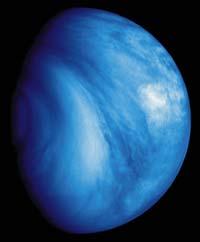The fruits of the mission Venus Express

The European Space Agency sent the Venus Express probe to investigate our neighboring planet, Venus. The mission has reached one year and the journal Nature published in November a series of articles with the first results.
Nine articles, thirty-four pages, all to talk about it. The main conclusion of the articles is the following: It was thought that Venus and Earth were similar, but studies show that they are more equal than we think. However, research will serve to understand the differences between both planets.
Venus is a terrifying place. It has a compact atmosphere, formed by carbon dioxide, with clouds of sulfuric acid. Atmospheric pressure on the surface of Venus is 90 times higher than on Earth and is almost 500 degrees away. In addition, corrosion is enormous on the surface of the planet. In October 1975 a probe landed on Venus and lasted less than an hour.
The Venus Express probe is externally investigating the atmosphere of Venus. Scientists have shown for the first time that rays are produced. And that oxygen and hydrogen are poured from the atmosphere into space along with helium. That is, the planet loses components of water, it is no wonder that it is dry. Scientists are surprised by the existence of a hot layer in the part of the atmosphere, supposedly cold. Until now they called it cryosphere... now they may have to change their name.

And what does this terrible planet resemble the Earth? The size, mass, and density of Venus are similar to those of Earth. We already knew that. But data from the Venus Express mission reveal the two trailers of its atmosphere, the North Pole and the South Pole. And there is similarity. They are similar to the atmosphere above Antarctica... of the part of the atmosphere that has the hole of the ozone layer.
Two astronomers from the University of the Basque Country, Agustín Sánchez Lavega and Ricardo West, participate in the investigation of the trailers. Of the nine articles published by Nature, two are the results of his research.





